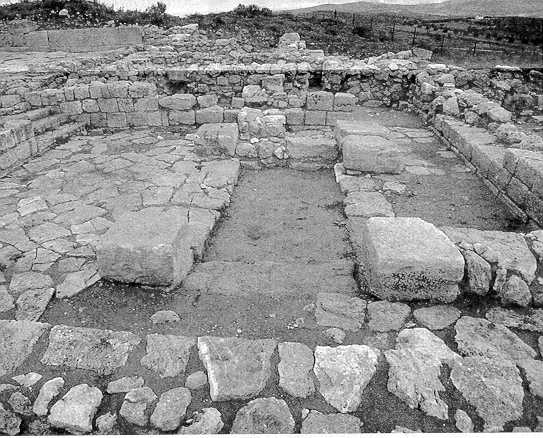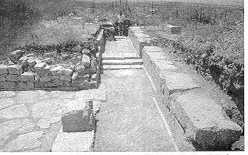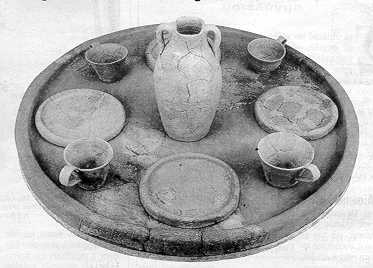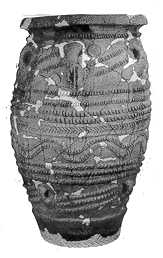 |
 |
In 1992 illegal excavations brought to light some minoan buildings. Last year (1997) the archaeologist in charge of the official excavations conducted now by the Greek Archaeological Service announced that a new Minoan Palace was unearthed in Galatianie Kephalas site (30 klms south of Herakleio, near Galatas village and 3 klms northwest of Arkalochorio village).
Although the area has been under excavations for more than five years, it was only in 1997 that archaeologist George Rethemiotakes revealed that the main building which he had been excavating and was located in the middle of a minoan town, had "all the characteristics of a minoan palace". It included a large centrally located and tiled (forty percent survives) court which measured 16 by 32 m. It was surrounded by a four wing building with walls covered by decorated plaster. The now lost frescoes included the oldest piece of Aegean mural safely dated around 1700 BC depicting an elevated wooden construction and a red wavy line. It is extremely important to Cretan archaeology that the building retains its 1600 BC design as compared to the other known palaces with mixed designs of various eras. Also, for the first time in a minoan palace the archaeologists have found a heart (3 by 1,5 m.) with a layer of ash. The hearth was in the middle of a room with four pillars [see image above] which reminds of a similar arrangement in the mycaenean palace of Pylos. Other excavated areas include corridors, a room with one pillar and benches, a room for the preparation of meals and a lot of ceramics.
 |
The east wing of the Galatianie Kephalas palace measures 70 by 60 m and is the only one that has been almost fully excavated. It was built between 1700-1650 BC but it was destroyed by fire and rebuilt fully between 1650-1600 BC. The following millennium (1600-1500 BC) it was occupied by "troglodytes" who built walls across the corridors and isolated various parts of the wing. The final destruction took place in 1500 BC by earthquakes.
The ceramic unearthed dates between 2000 BC and the late minoan period and includes pythi (huge vases), trays, cups, plates and various vases. Especially in the "kitchen" the excavators found a number of clay trays, 35 dishes and 70 soup dishes. Mr. Rethemiotakes claims that "the use of a monumental hearth in one of the rooms, the preparation of meals in the kitchen and the banquets offered in the room with the hearth and the room with the pillar and the benches or even upstairs, the storing of goods in the store rooms along with the personal appearances of the participants on the balconies toward the town and the central court of the palace, represent a symbolic meeting of the Town and the Palace which is ratified by the banquets".
 |  |
The excavator Mr. Rethemiotakes believes that the new discovery might prove that some architectural forms of palace building passed from minoan to mycaenean constructions. Also, he thinks that students of the minoan civilization must reconsider a lot of their ideas and theories concerning the function of the minoan palace on Crete.